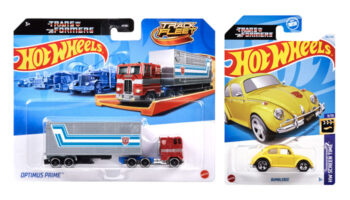Hues and Cues inventor Scott Brady on creativity, limits and getting to market

After launching his first game at New York Toy Fair, Scott Brady talks ideas, colours – and trading on the Moon.
Scott, lovely to meet you. You’re the inventor of one of my favourite games at New York Toy Fair; Hues and Cues…
It’s a pleasure to meet you as well, Deej! I’m happy to hear you enjoyed Hues and Cues. It wasn’t released at that point, so you’re one of the lucky few who got to experience it early!
I should probably add I was terrible at it! I think that’s a hallmark of a great game: you can suck at it, lose at it and still love it. I understand you’re not a full-time game inventor. What else keeps you busy?
You’re correct, I’m not a full-time inventor. Currently my days are full dealing with two teenagers who are schooling through a hybrid system of attendance. I’m also a writer and backend administrator for SahmReviews.com, my wife’s site of the past 15+ years… That focuses on the toy & game industry. Prior to that I was in the specialty printing industry for two decades.
For those that don’t know it, SahmReviews.com is an enormous and well-respected consumer-review site! And for those that don’t know Hues and Cues, can you give us the gist?
I consider Hues and Cues a party-style game since it accommodates up to ten players out of the box. Players give one-and-two-word clues to try to get the other players to guess which colour they’re describing. The twist is they can’t use colour clues like “blue” or “green” for example. They also can’t refer to anything in the room.

So it’s a case of identifying colours – and there are 480 on the board – without using obvious cues?
Exactly. You can, however, use abstract colour descriptors like “raspberry” or “lavender” or even name a colour associated with – say – a brand, animal or superhero! Players score based on how close their guess is to the secret colour. The person describing the colour also scores for each guess inside a scoring box. Everyone takes one or two turns as the cue-giver – and the person with the highest overall score wins.
It’s wonderfully original. How did you come up with the idea?
I mentioned before my experience in the printing industry. Part of any print shop is the need to colour match to a customer’s request…
You’re not going to tell me that’s done by people saying, “It’s like Superman’s cape!”?
There are days! But no, it’s usually done with various colour-matching systems. They simplify the process, especially in a time when all business is conducted by telephone or email. A colour matching system gives each person in the conversation a book of colours that match perfectly. The customer chooses the one they want, relays the colour code to the printer, and the company produces their item using ink of that exact shade. This solves the problem of a customer saying, “I wanted it more blue” or, “It’s not bright enough”.

Got it. You have the exact same reference points.
Right. So when it came to the design of Hues and Cues, I actually had two goals in mind. First, I’d never seen a game that really implemented colour theory in a way I found fun. Second, with two teenagers in the house, I had a desire to find a game that would appeal to not only them and us, but also their grandparents.
Interesting to hear that articulated as a real problem.
I’ve always found that most games that have a wide range of generations trying to play together give an advantage to one age group. If it’s a dexterity or speed game, younger players are always quicker. Older players always have an advantage when playing any type of word game due to a larger vocabulary.
But I guess perceiving colour is a more level field…
Yes. Because of my experience with colour theory, I knew everyone could describe colours using their own recollections – whether it’s comparing it to food items, their first car or their favourite Pokemon. That became the starting point.

I’m curious, then: could a colourblind person play this?
I think it’s natural for someone to assume a person who experiences some type of colour blindness can’t play a game about colour. Hues and Cues is most likely the only colour-based game which can be played by those with a colour deficiency without additional symbology or other assistance.
How come?
I consulted with a board-certified ophthalmologist during the design process. On top of that, I – and multiple publishers – tested the game with different players of all types of deficiencies. Because Hues and Cues isn’t about “what colour is an apple”… It’s about how one recalls or sees an apple, and how well it matches the other players’ perceptions of an apple, say. So players who see the colour spectrum differently will still see the hue in the same area of the board as you and I do.
Ah! Right… So if I see an apple a little brighter than you do, then I also see that colour on the board brighter than you do. It’s in the same place!
Of course, that’s assuming we’re both talking about the same shade of an apple to start with. A number of board-game reviewers and designers with colour deficiencies have given it their thumbs-up – and their win and lose record is the same as any other player.
The reason for the existence of colour-matching systems is because every single one of us sees colour differently, even when we don’t have a diagnosed deficiency! Of course, someone with the extremely rare condition of being able to only see in grayscale probably wouldn’t be able to compete. But this is typically the result of some type of traumatic brain injury or some other unfortunate incident.

I’m reminded of that optical illusion with the dress: some saw it as white others saw it as blue. Okay! Let me ask you this: in your experience, what helps creativity? What lets people have interesting ideas? Or solve problems?
That’s an interesting question. I don’t consider myself a creative person. I’ve always been more logical and “black and white”…
That irony isn’t lost on me!
For this, the creative process began by trying to find a solution to my problem: a multi-player game where age doesn’t play into the ability to win. I began working on it in solitude, only bouncing ideas off the rest of the family on occasion. The thing that played into my process the most was time. I was under no pressure to perform as this was just something to do. I had no inclination to have it published or let it see the light of day outside of my household.
So the game I saw wasn’t the first version?
No – Hues and Cues went through at least seven major iterations. It began as a card game and stayed that way for quite some time. It wasn’t until the fifth version that I added a board. That was after remembering there might be manufacturing issues trying to get card #1 to match card #150 perfectly every time.

Great! I like that a limitation forced the idea to take shape…
Yes, that worked for me. My ideas for the game came to me at the oddest times. In the shower or during twilight sleep while trying to wake up in the morning. For every hour I spent actively working on the game itself, I easily had it in my head four times as much just thinking through different aspects and possibilities.
I’m loving this, Scott! There are some great anecdotes about people having ideas in a hypnagogic or hypnopompic state – but very few in the toy-and-game industry. So to what degree do you have a specific creative process?
Is zero a valid answer?! When something comes to mind, I write it down and review it later when I have a few moments to see if there’s any validity in the thought. Other than that, I don’t have any formal creative process – or even scheduled time set aside to work on them!
Well… It’s been argued that writing things down is the most-important process! So is Hues and Cues your only game? Or have I missed some?
Hues and Cues is my first game design and the first published, so you haven’t missed anything! At the beginning of quarantine, I did release a game called Gekitai. When I saw people looking for games with low player counts, I made it free to download on BoardGameGeek. It’s an elegant abstract that plays in 10 minutes.

And are more ideas on the way?
I do have a couple of other designs in their late stages that I hope to pitch once I can get more outside playtesting done. Most of them are very different from Hues and Cues. Chicken-n-Waffles is a speed-based, set-making card game. Sonoma is an intro-level pick-up-and-deliver game about grape harvesting with a very puzzly tile-laying feature. Ink Sync is also colour-based, but it’s a cooperative puzzle challenge instead of a board game.
Strewth! You’ve certainly been busy!
Ha! Quarantine does that to people, I think… I also have an unnamed drawing game that uses a unique mechanic to create rough images and has competitive scoring for everyone, similar to Hues and Cues. So those are really close to being done. Others, like a 3-D area-control game, or a trick-taking game where you don’t know the results of your play until all cards are revealed are still very early in the design process. That doesn’t count the pile of others that will never see the light of day for one reason or another.
Fantastic. So presumably then, at some point, you looked at Hues and Cues and thought: this idea should see the light of day… This is good enough to show people. How did that happen? To whom did you pitch it?
Once I had a game our family enjoyed, I had a more professional copy of the board made at Fed Ex. We took the game to our weekly game nights where typically 30 or so people attend. These are gaming friends who wouldn’t be afraid to really tell us what they thought. I was very nervous to make it public, but did so at the insistence of my wife. I’m glad I did because it was those friends who really got excited and encouraged me to show it to some of our industry friends. Months later, I took my one copy to Geekway to the West…

Sorry; to clarify: Geekway to the West is a convention?
Yes. It’s held in St. Charles, Missouri. And it’s pretty big… People playing, selling and testing games. And I knew a number of publisher friends would be in attendance so I went along. Amazingly, I literally had offers on the spot from multiple companies. The real catalyst came from a hobby game publisher who pulled us aside as advised that we needed to look bigger than just going with a hobby game maker, even though they were interested themselves. We left Geekway and began scheduling meetings with a handful of larger publishers at Origins.
Another convention…
Right. And there was great interest from a number of them, including some with an international presence. I felt strongly that I wanted a company that had its feet in both the mass-market and hobby game worlds – and there are very few that can claim both. Even then, word got around and we were being chased down and asked to demo it at no less than ten other booths!
Including USAopoly, I assume? And when they saw it, what happened next?
There’s a funny story about my pitch to The Op which they like to tell… I met with their lead game developer, and our contact from marketing. We spread out the large board on one of their display tables in the convention hall. Then we started playing a few rounds so they could learn what the game was about. Before we knew it, a small crowd started to form… One family even asked to join in a game during the pitch!

Great compliment! And with The Op on board, what was it like developing the idea?
Once we came to a publishing agreement, the development was almost seamless. I’d originally named the game something else, so they came up with the brand Hues and Cues. The game relies heavily on the design of the board, so they were able to use what I provided as-is. On their end, all they needed to do was talk about components, discuss manufacturing issues and design the box and rulebook. There was very little additional development to the game itself.
Wow! Kudos. So given that this is your first game, and that you seem to have nailed it, what advice would you give to other full-time humans? And part-time game inventors?
I think anyone who has a specialty in life, whether a chef, engineer, doctor or lawyer, could probably find a way to gamify the best and worst parts of their jobs. I would encourage anyone who has a desire to invent a game to begin with the subject they know well. This alone gives them a leg-up on other designers as they’re the expert in that field. Also, don’t be afraid to listen to what others have to say about your game. Criticisms will arise – it’s how you address them that’s important. You don’t have to take the suggestion of every armchair designer, but their opinions are still valuable.
Super! And in terms of moving a game forward?
If you have a desire to have a game published, start networking now. Because we’re friends with so many publishers, doors were open for us to soft-pitch our idea. Knowing a company and their employees gives you great insight into what games they’re looking for, how well you might work with them, and their reputation in the industry. Begin by volunteering at conventions or engaging with them on social media. Most publishers are investing in the designer as much as they are the game!

Great stuff. We need to wrap this up now, Scott… Like the rest of the year, the time’s flown by! Just two more thoughts: first, if I wanted to get an interesting answer from you – one nobody else is likely to get – what question would I have to ask?
You’d ask me, “Other than game design, if you could have your dream job, what would it be?”
To which you’d say…
I’d say I hope to be the owner of first bakery on the Moon. Our specialty would be, of course, Moon Pies!
Of course! Thank you! And finally, then, what’s the most interesting thing on your desk?
My very-cluttered desk! Looking around, the thing that catches my eye is one of the first things I purchased with my own money back in the 70s. It’s a 4″ tall, yellow, plastic garbage can filled with rubber alien monsters. There’s no branding on it, just “Made in Japan” moulded in the plastic. I most likely purchased it while living in West Germany – and, for some reason, always kept it.

Wonderful! Scott, this has been a genuine pleasure. Congratulations again on Hues and Cues. And Happy New Year to you! Best of luck with the new games; let’s tie in again when they’re over the line.
—-
To stay in the loop with the latest news, interviews and features from the world of toy and game design, sign up to our weekly newsletter here























